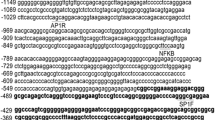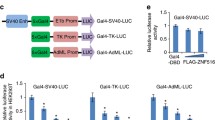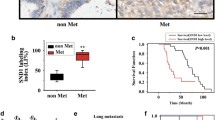Abstract
SNAI1P, a protein coded by a retrogene, is a member of the SNAI family of E2-box binding transcriptional repressors. To evaluate whether the mode of action of SNAI1P is similar to those of the other predominant members of the SNAI family, we studied its action on human claudin 7 (CLDN7) gene promoter which has seven E2-boxes. We over-expressed FLAG-tagged SNAI1P in MCF7 and MDA-MB-468 cells. SNAI1P inhibited the expression of CLDN7 in these recombinant cells. SNAI1P also inhibited cloned CLDN7 gene promoter activity in human breast cancer cells. ChIP assays revealed that SNAI1P is recruited on the CLDN7 gene promoter along with the co-repressor CtBP1 and the effector HDAC1. Treatment of the cells with trichostatin A, an inhibitor of HDAC1, abrogated the repressor activity of SNAI1P. These data suggest that SNAI1P inhibits CLDN7 gene promoter epigenetically in breast cancer cells through chromatin remodeling.




Similar content being viewed by others
Abbreviations
- SNAI1L1:
-
SNAIL-like 1
- CLDN7:
-
Claudin 7
- TSA:
-
Trichostatin A
- CtBP1:
-
C-terminal binding protein 1
- HDAC1:
-
Histone deacetylase 1
- PRMT1:
-
Protein arginine methyl transferase 1
- HMT1:
-
Histone methyl transferase 1
References
Nieto MA (2002) The Snail superfamily of zinc-finger transcription factors. Nat Rev Mol Cell Biol 3:155–166. doi:10.1038/nrm757
Barrallo-Gimeno A, Nieto MA (2005) The Snail genes as inducers of cell movement and survival: implications in development and cancer. Development 132:3151–3161. doi:10.1242/dev.01907
Peinado H, Olmeda D, Cano A (2007) Snail, Zeb and bHLH factors in tumour progression: an alliance against the epithelial phenotype? Nat Rev Cancer 7:415–428. doi:10.1038/nrc2131
Moreno-Bueno G, Portillo F, Cano A (2008) Transcriptional regulation of cell polarity in EMT and cancer. Oncogene 27:6958–6969. doi:10.1038/onc.2008.346
Dhasarathy A, Kajita M, Wade PA (2007) The transcription factor snail mediates epithelial to mesenchymal transitions by repression of estrogen receptor-alpha. Mol Endocrinol 21:2907–2918. doi:10.1210/me.2007-0293
Côme C, Magnino F, Bibeau F, De Santa Barbara P, Becker KF, Theillet C, Savagner P (2006) Snail and slug play distinct roles during breast carcinoma progression. Clin Cancer Res 12:5395–5402. doi:10.1158/1078-0432.CCR-06-0478
Paznekas WA, Okajima K, Schertzer M, Wood S, Jabs EW (1999) Genomic organization, expression, and chromosome location of the human SNAIL gene (SNAI1) and a related processed pseudogene (SNAI1P). Genomics 62:42–49. doi:10.1006/geno.1999.6010
Locascio A, Vega S, de Frutos CA, Manzanares M, Nieto MA (2002) Biological potential of a functional human SNAIL retrogene. J Biol Chem 277:38803–38809. doi:10.1074/jbc.M205358200
Ko H, Kim HS, Kim NH, Lee SH, Kim KH, Hong SH, Yook JI (2007) Nuclear localization signals of the E-cadherin transcriptional repressor Snail. Cells Tissues Organs 185:66–72. doi:10.1159/000101305
Hou Z, Peng H, Ayyanathan K, Yan KP, Langer EM, Longmore GD, Rauscher FJ 3rd (2008) The LIM protein AJUBA recruits protein arginine methyltransferase 5 to mediate SNAIL-dependent transcriptional repression. Mol Cell Biol 28:3198–3207. doi:10.1128/MCB.01435-07
Yook JI, Li XY, Ota I, Hu C, Kim HS, Kim NH, Cha SY, Ryu JK, Choi YJ, Kim J, Fearon ER, Weiss SJ (2006) A Wnt-Axin2-GSK3beta cascade regulates Snail1 activity in breast cancer cells. Nat Cell Biol 8:1398–1406. doi:10.1038/ncb1508
Twigg SR, Wilkie AO (1999) Characterisation of the human snail (SNAI1) gene and exclusion as a major disease gene in craniosynostosis. Hum Genet 105:320–326. doi:10.1007/s004390051108
Okubo T, Truong TK, Yu B, Itoh T, Zhao J, Grube B, Zhou D, Chen S (2001) Down-regulation of promoter 1.3 activity of the human aromatase gene in breast tissue by zinc-finger protein, snail (SnaH). Cancer Res 61:1338–1346
Moody SE, Perez D, Pan TC, Sarkisian CJ, Portocarrero CP, Sterner CJ, Notorfrancesco KL, Cardiff RD, Chodosh LA (2005) The transcriptional repressor Snail promotes mammary tumor recurrence. Cancer Cell 8:197–209. doi:10.1016/j.ccr.2005.07.009
Davidson NE, Sukumar S (2005) Of Snail, mice, and women. Cancer Cell 8:173–174. doi:10.1016/j.ccr.2005.08.006
De Craene B, Berx G (2006) Snail in the frame of malignant tumor recurrence. Breast Cancer Res 8:105. doi:10.1186/bcr1521
Martínez-Estrada OM, Cullerés A, Soriano FX, Peinado H, Bolós V, Martínez FO, Reina M, Cano A, Fabre M, Vilaró S (2006) The transcription factors Slug and Snail act as repressors of Claudin-1 expression in epithelial cells. Biochem J 394:449–457. doi:10.1042/BJ20050591
Martin TA, Goyal A, Watkins G, Jiang WG (2005) Expression of the transcription factors snail, slug, and twist and their clinical significance in human breast cancer. Ann Surg Oncol 12:488–496. doi:10.1245/ASO.2005.04.010
Chiba H, Osanai M, Murata M, Kojima T, Sawada N (2008) Transmembrane proteins of tight junctions. Biochim Biophys Acta 1778:588–600. doi:10.1016/j.bbamem.2007.08.017
Krause G, Winkler L, Mueller SL, Haseloff RF, Piontek J, Blasig IE (2008) Structure and function of claudins. Biochim Biophys Acta 1778:631–645
Tripathi MK, Misra S, Khedkar SV, Hamilton N, Irvin-Wilson C, Sharan C, Sealy L, Chaudhuri G (2005) Regulation of BRCA2 gene expression by the SLUG repressor protein in human breast cells. J Biol Chem 280:17163–17171. doi:10.1074/jbc.M501375200
Bailey CK, Misra S, Mittal MK, Chaudhuri G (2007) Human SLUG does not directly bind to CtBP1. Biochem Biophys Res Commun 353:661–664. doi:10.1016/j.bbrc.2006.12.097
Mittal M, Myers JN, Misra S, Bailey CK, Chaudhuri G (2008) In vivo binding to and functional repression of the VDR gene promoter by SLUG in human breast cells. Biochem Biophys Res Commun 372:30–34. doi:10.1016/j.bbrc.2008.04.187
Bennett RD, Mauer AS, Strehler EE (2007) Calmodulin-like protein increases filopodia-dependent cell motility via up-regulation of myosin-10. J Biol Chem 282:3205–3212. doi:10.1074/jbc.M607174200
Xia Y, Wen HY, Kellems RE (2002) Angiotensin II inhibits human trophoblast invasion through AT1 receptor activation. J Biol Chem 277:24601–24608. doi:10.1074/jbc.M201369200
Yamasaki H, Sekimoto T, Ohkubo T, Douchi T, Nagata Y, Ozawa M, Yoneda Y (2005) Zinc finger domain of Snail functions as a nuclear localization signal for importin beta-mediated nuclear import pathway. Genes Cells 10:455–464. doi:10.1111/j.1365-2443.2005.00850.x
Kwon YS, Garcia-Bassets I, Hutt KR, Cheng CS, Jin M, Liu D, Benner C, Wang D, Ye Z, Bibikova M, Fan JB, Duan L, Glass CK, Rosenfeld MG, Fu XD (2007) Sensitive ChIP-DSL technology reveals an extensive estrogen receptor alpha-binding program on human gene promoters. Proc Natl Acad Sci USA 104:4852–4857. doi:10.1073/pnas.0700715104
Kominsky SL, Argani P, Korz D, Evron E, Raman V, Garrett E, Rein A, Sauter G, Kallioniemi OP, Sukumar S (2003) Loss of the tight junction protein claudin-7 correlates with histological grade in both ductal carcinoma in situ and invasive ductal carcinoma of the breast. Oncogene 22:2021–2033. doi:10.1038/sj.onc.1206199
Oshima T, Kunisaki C, Yoshihara K, Yamada R, Yamamoto N, Sato T, Makino H, Yamagishi S, Nagano Y, Fujii S, Shiozawa M, Akaike M, Wada N, Rino Y, Masuda M, Tanaka K, Imada T (2008) Reduced expression of the claudin-7 gene correlates with venous invasion and liver metastasis in colorectal cancer. Oncol Rep 19:953–959
Lioni M, Brafford P, Andl C, Rustgi A, El-Deiry W, Herlyn M, Smalley KS (2007) Dysregulation of claudin-7 leads to loss of E-cadherin expression and the increased invasion of esophageal squamous cell carcinoma cells. Am J Pathol 170:709–721. doi:10.2353/ajpath.2007.060343
Ayyanathan K, Peng H, Hou Z, Fredericks WJ, Goyal RK, Langer EM, Longmore GD, Rauscher FJ 3rd (2007) The Ajuba LIM domain protein is a corepressor for SNAG domain mediated repression and participates in nucleocytoplasmic shuttling. Cancer Res 67:9097–9106. doi:10.1158/0008-5472.CAN-07-2987
Acknowledgments
This work was supported by the DOD-CDMRP IDEA Grant # W81XWH-06-1-0466 to GC. Immunofluorescence analysis was performed in the MMC Morphology Core facility (supported by NIH grants U54NS041071-06, G12RR03032-19, U54CA91408, and U54RR019192-04).
Author information
Authors and Affiliations
Corresponding author
Rights and permissions
About this article
Cite this article
Mittal, M.K., Myers, J.N., Bailey, C.K. et al. Mode of action of the retrogene product SNAI1P, a SNAIL homolog, in human breast cancer cells. Mol Biol Rep 37, 1221–1227 (2010). https://doi.org/10.1007/s11033-009-9492-8
Received:
Accepted:
Published:
Issue Date:
DOI: https://doi.org/10.1007/s11033-009-9492-8




